
26 January 1990: The Lockheed SR-71A “Blackbird” is retired from service at Beale Air Force Base, California. This would prove to be a premature decision.
© 2017, Bryan R. Swopes
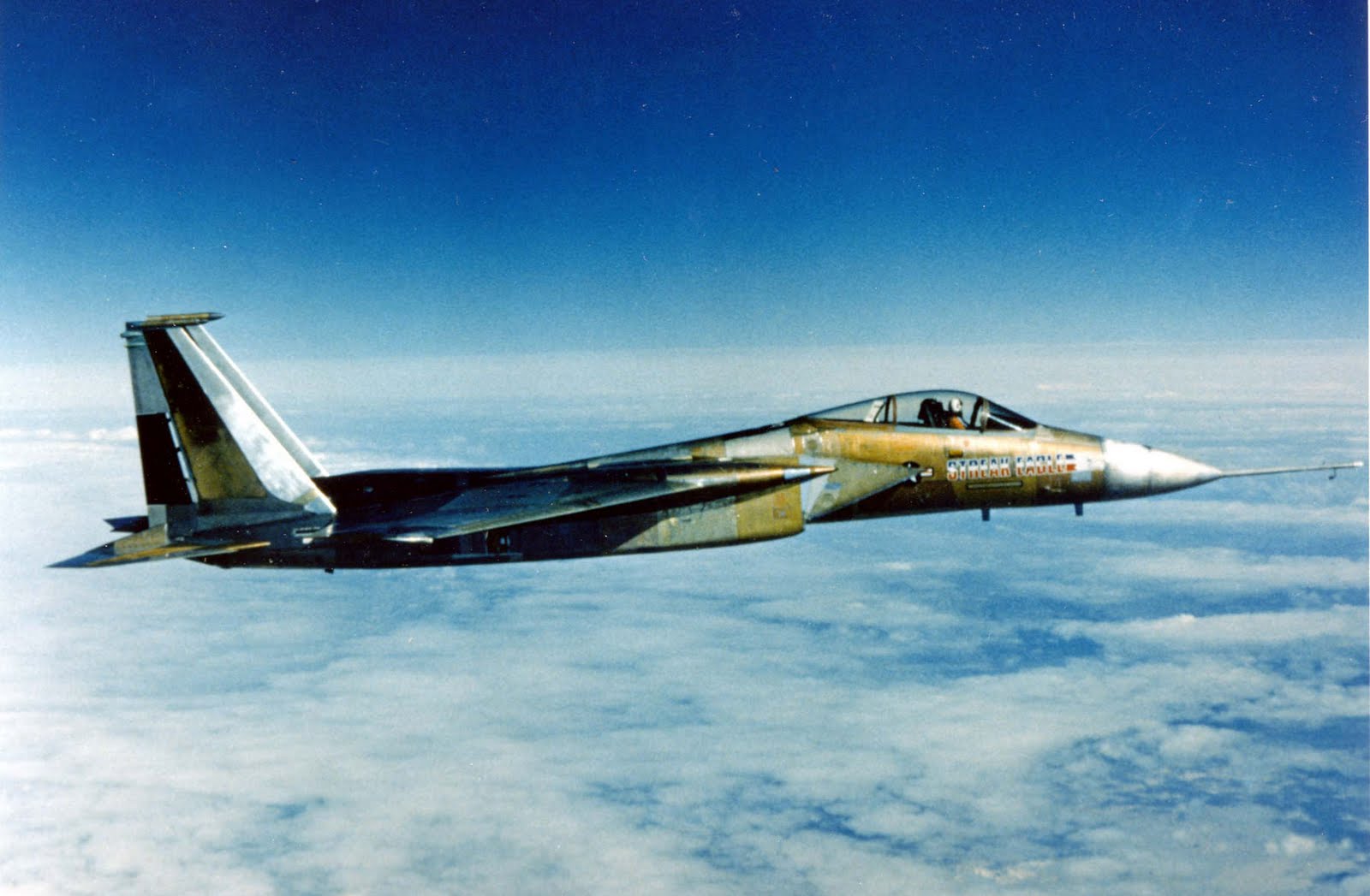
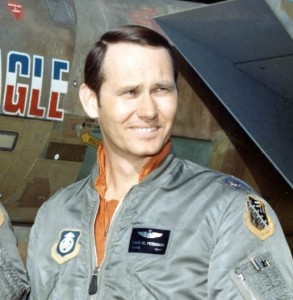
26 January 1975: In a continuing series of time-to-altitude records, Major David W. Peterson, U.S. Air Force, a test pilot assigned to the F-15 Joint Test Force at Edwards AFB, California, ran the engines of the McDonnell Douglas F-15A-6-MC, 72-0119, Streak Eagle to full afterburner while it was attached to a hold-back device on the runway at Grand Forks Air Force Base, North Dakota. The fighter was released and 161.025 seconds later it climbed through 82,020.997 feet (25,000 meters), setting another Fédération Aéronautique Internationale (FAI) world record. This was the seventh time-to-altitude record set by the modified F-15 in just ten days.
FAI Record File Num #9070 [Direct Link]
Status: ratified – retired by changes of the sporting code
Region: World
Class: C (Powered Aeroplanes)
Sub-Class: C-1 (Landplanes)
Category: Not applicable
Group: 3 : turbo-jet
Type of record: Time to climb to a height of 25 000 m
Performance: 2 min 41.025s
Date: 1975-01-26
Course/Location: Grand Forks, ND (USA)
Claimant David W. Peterson (USA)
Aeroplane: McDonnell Douglas F-15
Engines: 2 Pratt & Whitney F-100
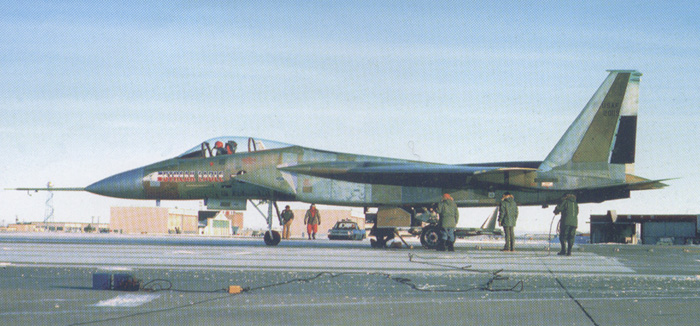
 Streak Eagle is a very early production F-15A-6-MC Eagle, a single-seat, twin-engine air superiority fighter. It is 63 feet, 9.0 inches (19.431 meters) long with a wingspan of 42 feet, 9.7 inches (13.048 meters) and overall height of 18 feet, 5.4 inches (5.624 meters). The F-15A has an empty weight of 25,870 pounds (11,734 kilograms) and its maximum takeoff weight (MTOW) is 44,497 pounds (20,184 kilograms).
Streak Eagle is a very early production F-15A-6-MC Eagle, a single-seat, twin-engine air superiority fighter. It is 63 feet, 9.0 inches (19.431 meters) long with a wingspan of 42 feet, 9.7 inches (13.048 meters) and overall height of 18 feet, 5.4 inches (5.624 meters). The F-15A has an empty weight of 25,870 pounds (11,734 kilograms) and its maximum takeoff weight (MTOW) is 44,497 pounds (20,184 kilograms).
 The F-15A is powered by two Pratt & Whitney JTF22A-25A (F100-PW-100) afterburning turbofan engines. The F100 is a two-spool, axial-flow turbine engine with a 3-stage fan section; 10-stage compressor; single chamber combustion section; and 4-stage turbine (2 low- and 2 high-pressure stages). The engine has a Maximum Continuous Power rating of 12,410 pounds of thrust (55.202 kilonewtons); 14,690 pounds (65.344 kilonewtons, 30-minute limit; and a maximum 23,840 pounds (106.046 kilonewtons), 5-minute limit. The F100-PW-100 is 191 inches (4.851 meters) long, 46.5 inches (1.181 meters) in diameter, and weighs 3,035 pounds (1,376.7 kilograms).
The F-15A is powered by two Pratt & Whitney JTF22A-25A (F100-PW-100) afterburning turbofan engines. The F100 is a two-spool, axial-flow turbine engine with a 3-stage fan section; 10-stage compressor; single chamber combustion section; and 4-stage turbine (2 low- and 2 high-pressure stages). The engine has a Maximum Continuous Power rating of 12,410 pounds of thrust (55.202 kilonewtons); 14,690 pounds (65.344 kilonewtons, 30-minute limit; and a maximum 23,840 pounds (106.046 kilonewtons), 5-minute limit. The F100-PW-100 is 191 inches (4.851 meters) long, 46.5 inches (1.181 meters) in diameter, and weighs 3,035 pounds (1,376.7 kilograms).
The cruise speed of the F-15A Eagle is 502 knots (578 miles per hour/930 kilometers per hour). It has a maximum speed of 893 knots (1,028 miles per hour/1,654 kilometers per hour) at 10,000 feet (3,048 meters), and 1,434 knots (1,650 miles per hour/2,656 kilometers per hour) at 45,000 feet (13,716 meters). The ceiling is 63,050 feet (19,218 meters) at maximum power. It can climb at an initial 67,250 feet per minute (342 meters per second) from Sea Level, and with a thrust-to-weight ratio of 1.15:1, The F-15 can climb straight up. The Eagle’s combat radius is 638 nautical miles (734 statute miles/1,182kilometers).
The F-15A is armed with one General Electric M61A1 Vulcan 20mm rotary cannon with 938 rounds of ammunition, four AIM-7 Sparrow radar-guided missiles and four AIM-9 Sidewinder heat-seeking missiles.
384 F-15A Eagles were built before production shifted to the improved F-15C version. As F-15Cs became operation, the F-15As were transferred to Air National Guard units assigned to defend continental U.S. airspace. The last F-15A was retired from service in 2009.
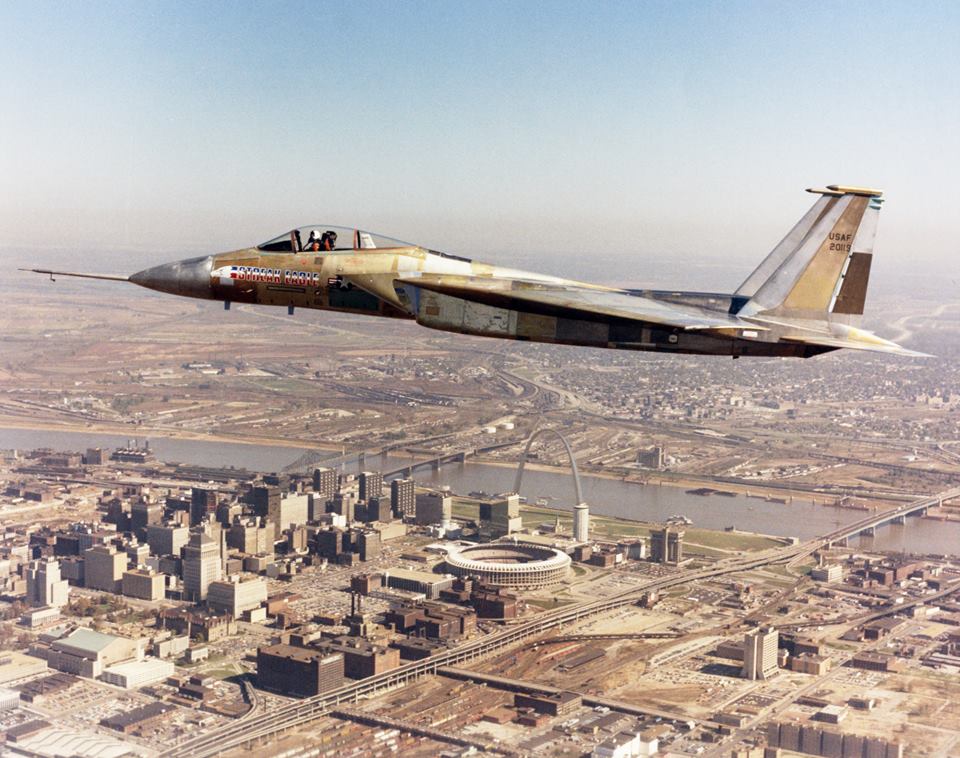
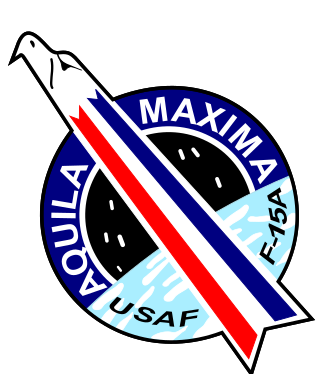 Streak Eagle was specially modified for the record attempts. Various equipment that would not be needed for these flights was eliminated: The flap and speed brake actuators, the M61A1 Vulcan 20 mm cannon and its ammunition handling equipment, the radar and fire control systems, unneeded cockpit displays and radios, and one generator.
Streak Eagle was specially modified for the record attempts. Various equipment that would not be needed for these flights was eliminated: The flap and speed brake actuators, the M61A1 Vulcan 20 mm cannon and its ammunition handling equipment, the radar and fire control systems, unneeded cockpit displays and radios, and one generator.
Other equipment was added: A long pitot boom was mounted at the nose with alpha and beta vanes, equipment for the pilot’s David Clark Company A/P-225-6 full pressure suit, extremely sensitive accelerometers and other instrumentation, extra batteries, an in-cockpit video camera aimed over the pilot’s shoulder, and perhaps most important, a special hold-down device was installed in place of the fighter’s standard arresting hook.
These changes resulted in an airplane that was approximately 1,800 pounds (817 kilograms) lighter than the standard production F-15A. This gave it a thrust-to-weight ratio of 1.4:1.
The flight profiles for the record attempts were developed by McDonnell Douglas Chief Experimental Test Pilot, Charles P. “Pete” Garrison (Lieutenant Colonel, U.S. Air Force, Retired).
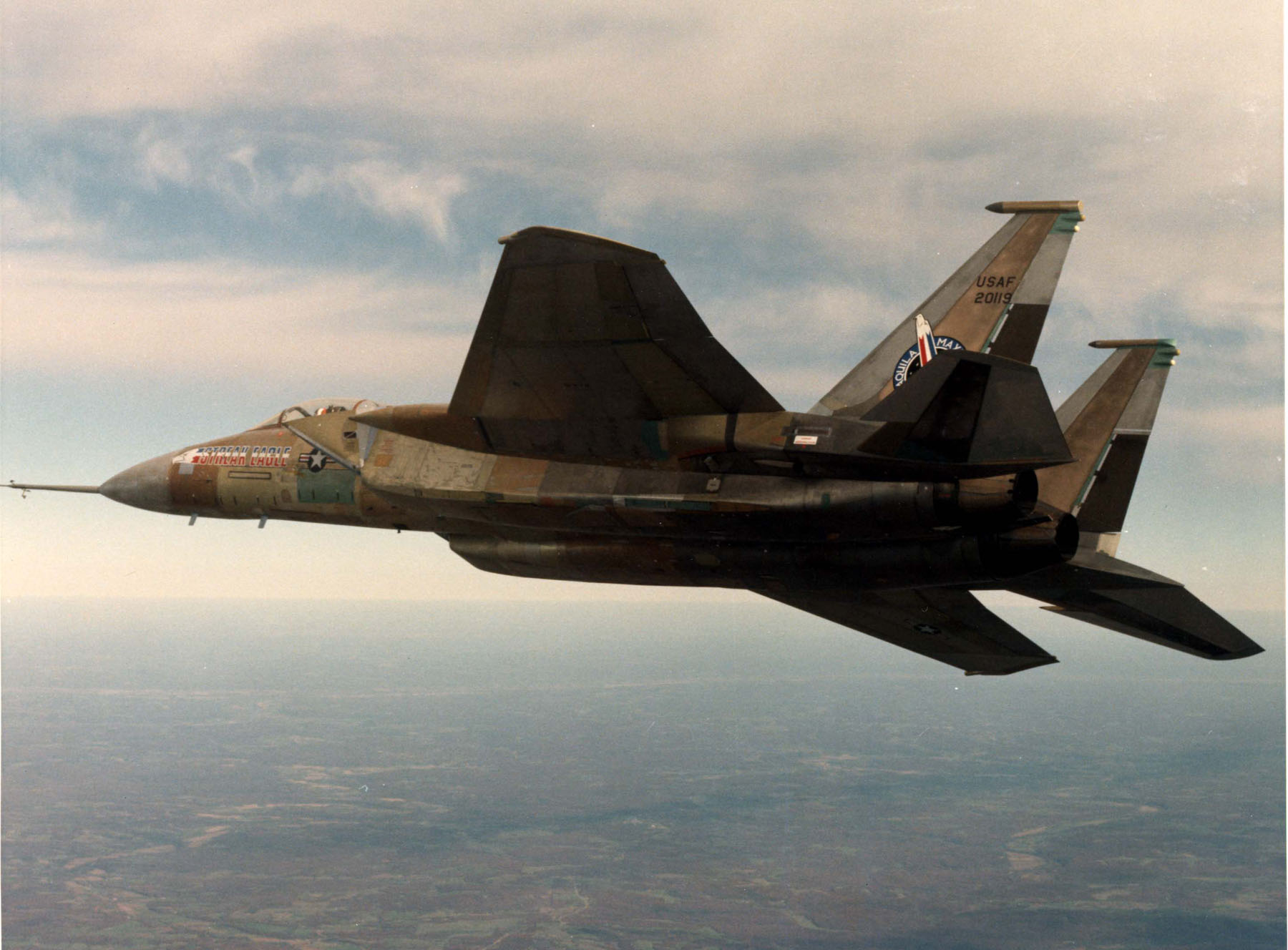
Streak Eagle carried only enough fuel for each specific flight, and weighed 36,709 pounds (16.650.9 kilograms). It was secured to the hold-back device on the runway and the engines were run up to full afterburner. It was released from the hold-back and was airborne in just three seconds.
When the F-15 reached 428 knots (793.4 kilometers per hour), the pilot pulled up into an Immelman turn, holding 2.5 Gs. Streak Eagle would arrive back over the air base, in level flight at about 32,000 feet (9,754 meters), but upside down. Rolling up right, Streak Eagle continued accelerating to Mach 1.8 and the pilot would pull the fighter up at 4.0 Gs until it reached a 55° climb angle. He held 55° until he had reached 25,000 meters, then pushed over. Streak Eagle returned to land at Grand Forks.
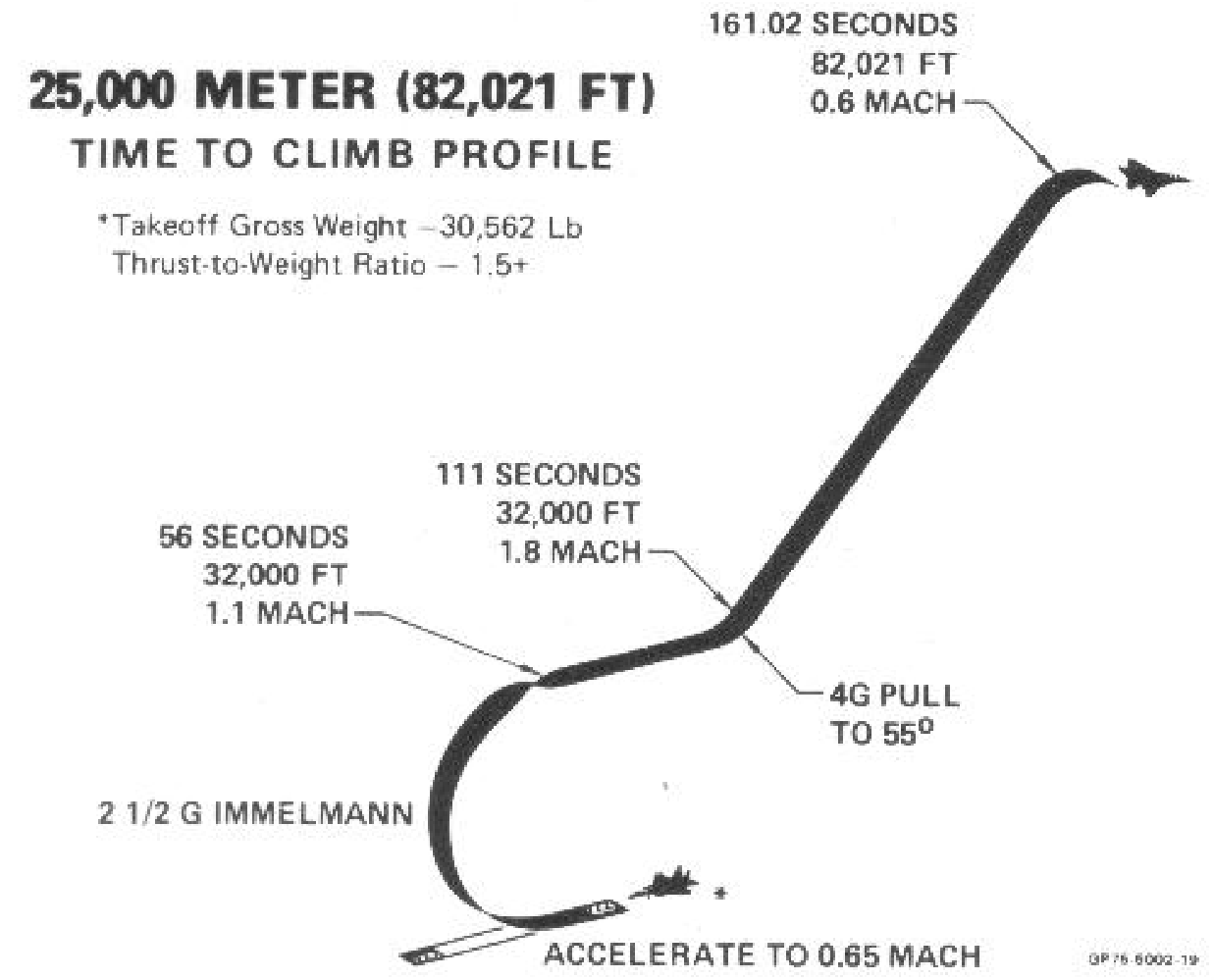 Because Streak Eagle was a very early production airplane, its internal structure was weaker than the final production F-15A standard. It was considered too expensive to modify it to the new standard. It was transferred to the National Museum of the United States Air Force at Wright-Patterson Air Force Base, Ohio, in December 1980.
Because Streak Eagle was a very early production airplane, its internal structure was weaker than the final production F-15A standard. It was considered too expensive to modify it to the new standard. It was transferred to the National Museum of the United States Air Force at Wright-Patterson Air Force Base, Ohio, in December 1980.
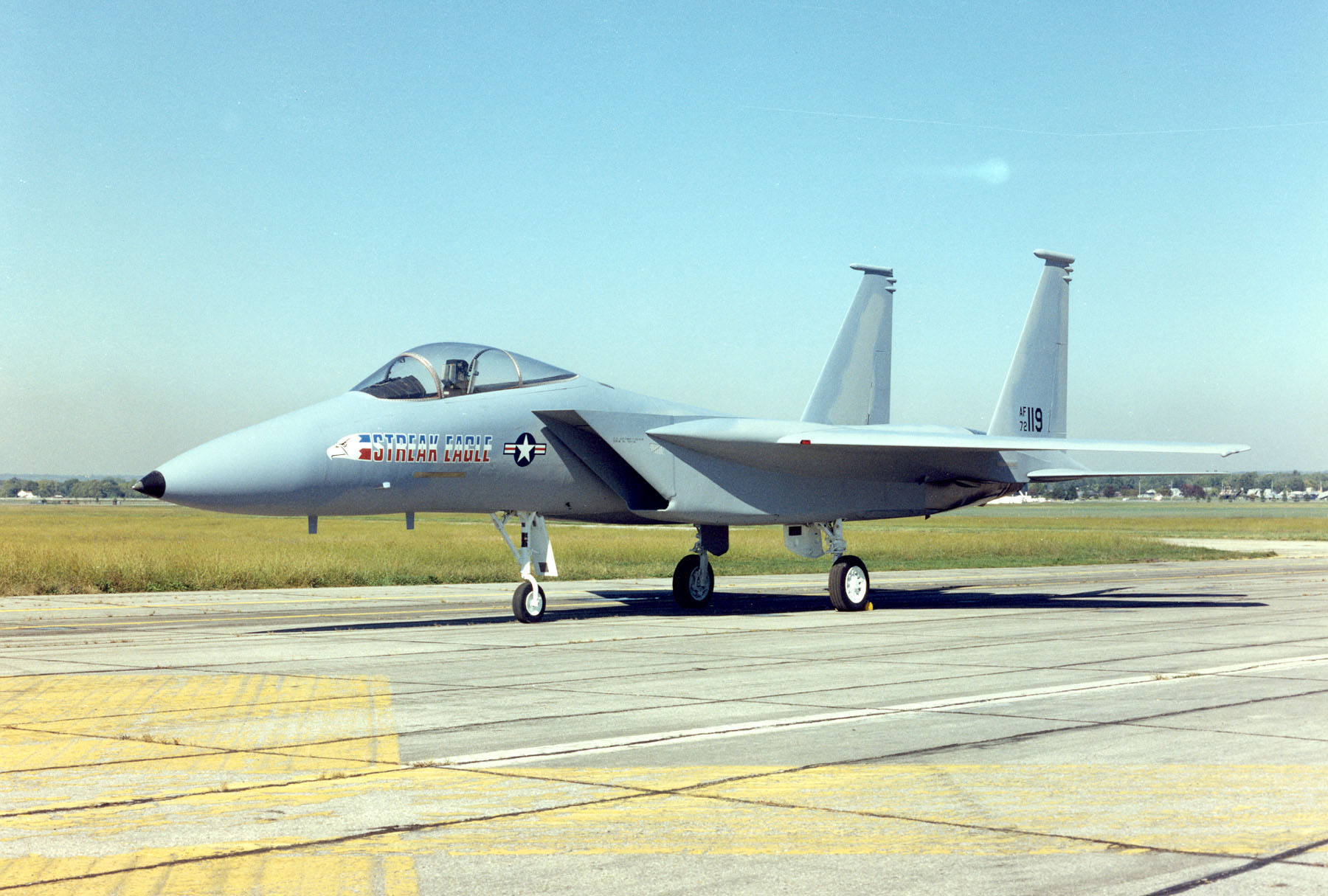
© 2019, Bryan R. Swopes
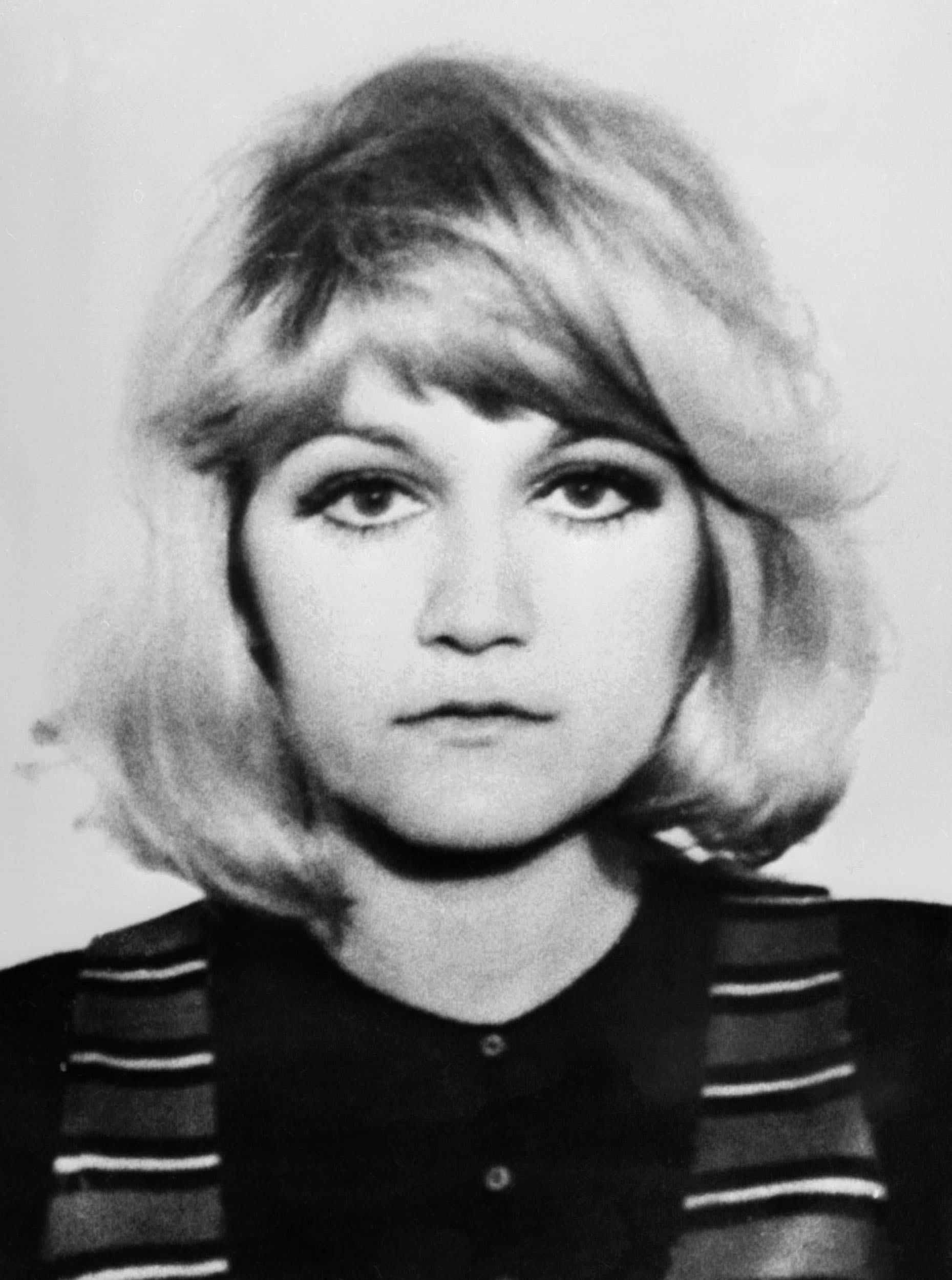
 26 January 1972: Miss Vesna Vulović was a flight attendant aboard Jugoslavenski Aerotransport (JAT) Flight 367, en route from Copenhagen, Denmark, to Zagreb, Yugoslavia.
26 January 1972: Miss Vesna Vulović was a flight attendant aboard Jugoslavenski Aerotransport (JAT) Flight 367, en route from Copenhagen, Denmark, to Zagreb, Yugoslavia.
The airliner, a McDonnell Douglas DC-9-32, YU-AHT, was nearly new. It had made its first flight the previous year and had a total 2,091 hours.
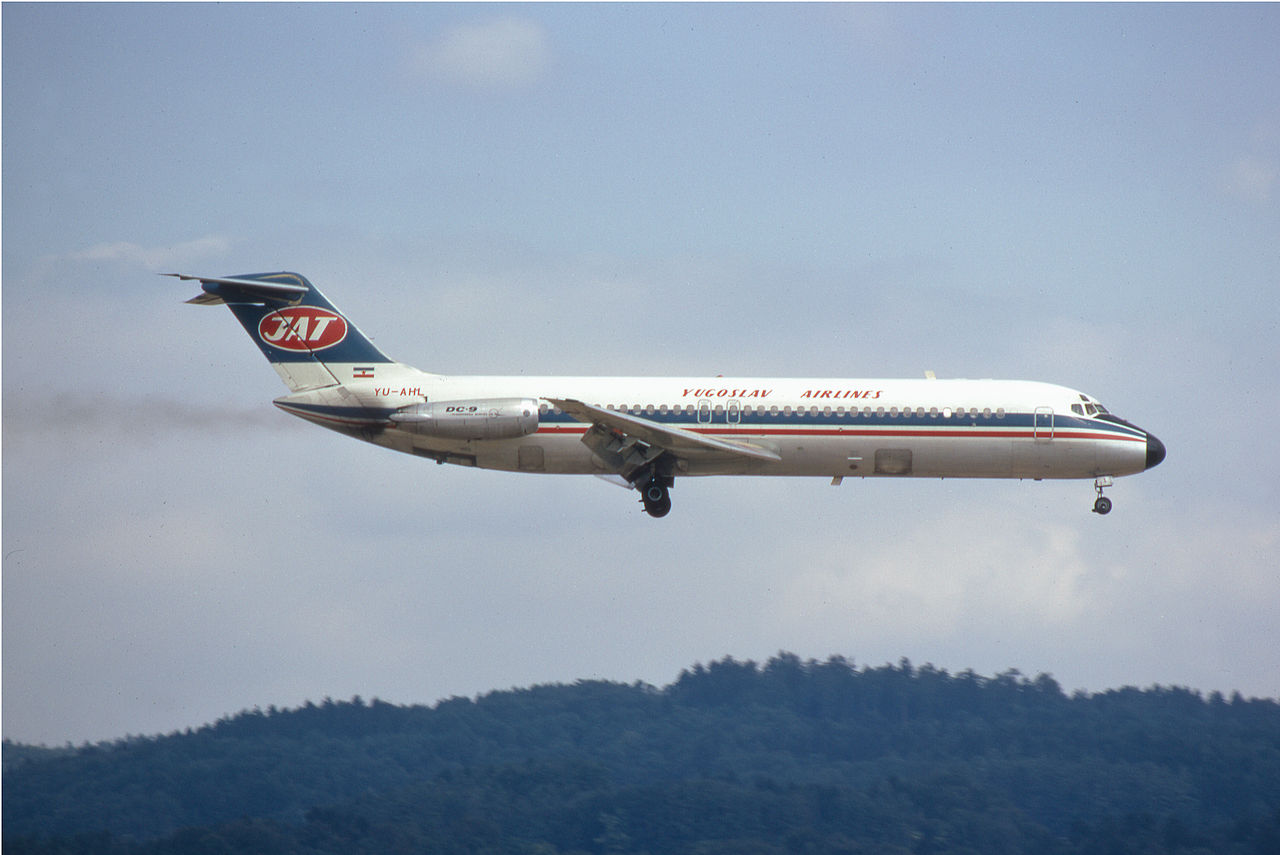
At 4:01 p.m., over Srbská Kamenice, Czechoslovakia, a bomb exploded in the airliner’s baggage compartment. As the airplane broke apart from the force of the explosion and decompression, 19 people fell from the disintegrating passenger cabin. Wreckage of the DC-9 was dispersed over several kilometers.
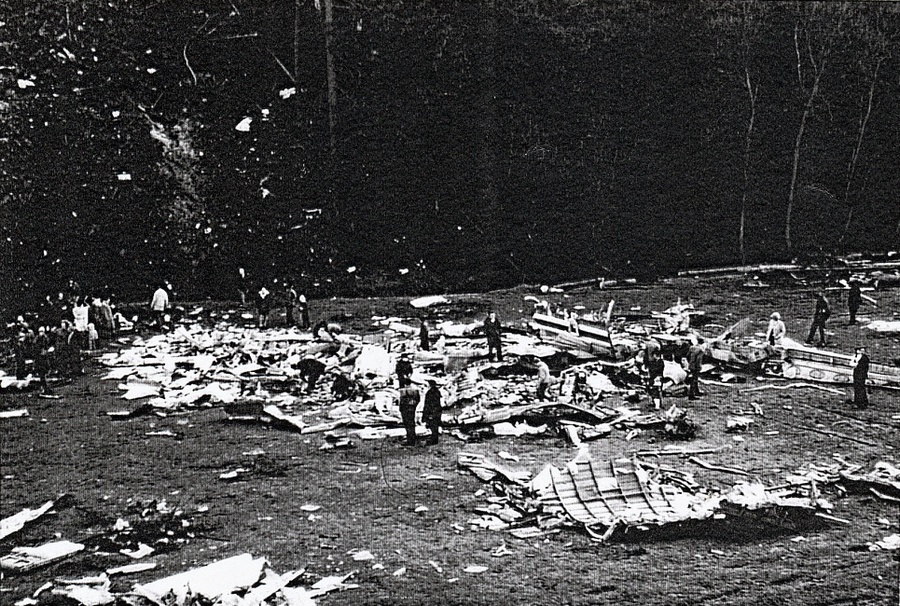
Miss Vulović was among those who fell. According to Guinness World Records, she fell 10,160 meters (33,333 feet), and though she was severely injured, she survived. The remainder of the passengers and crew were killed.
Miss Vulović was in a coma for 27 days, and never regained memory of the incident. She was paralyzed below her waist for several months and remained hospitalized for 1 year, 4 months.
In 1985, Guinness credited her with the “highest fall survived without a parachute.” The award was presented by Paul McCartney.
Miss Vulović was born in Belgrade, Federal People’s Republic of Yugoslavia, 3 January 1950. She died there 23 December 2016 at the age of 66 years. She was buried at Novo groblje, a cemetery in Belgrade, Republic of Serbia.
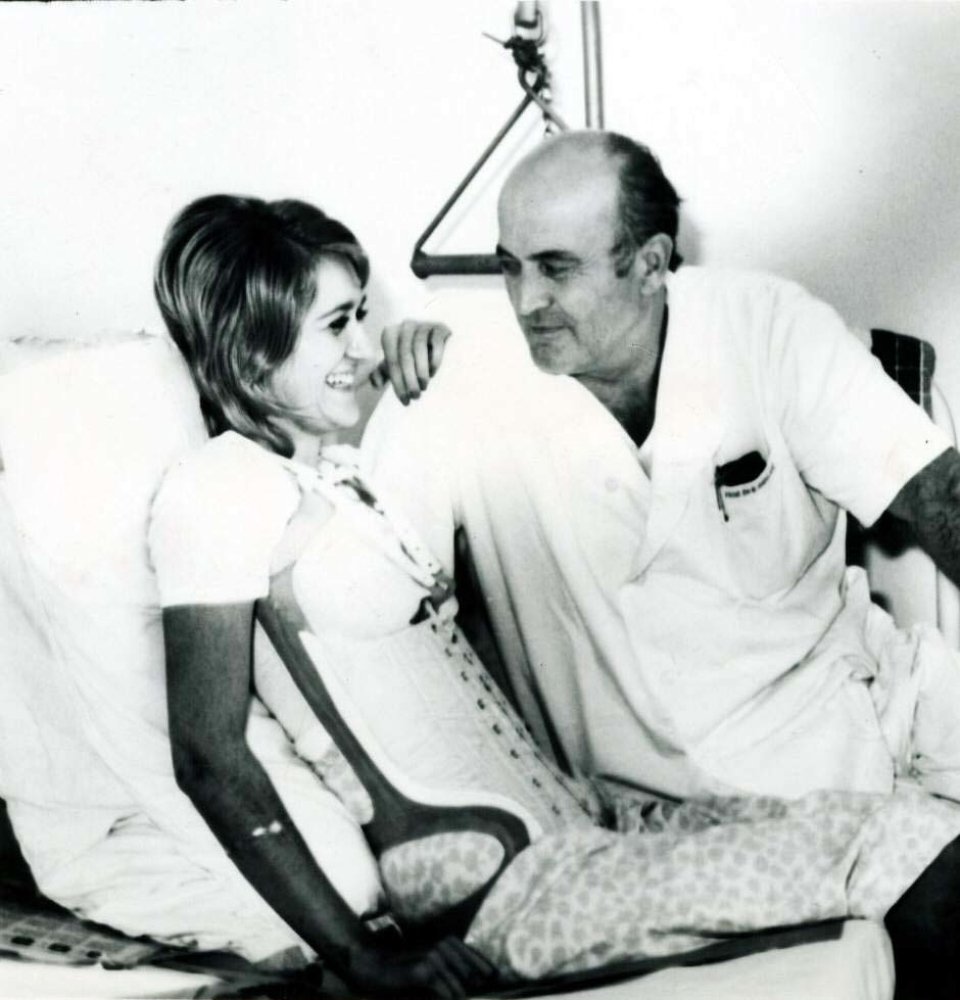
© 2019, Bryan R. Swopes
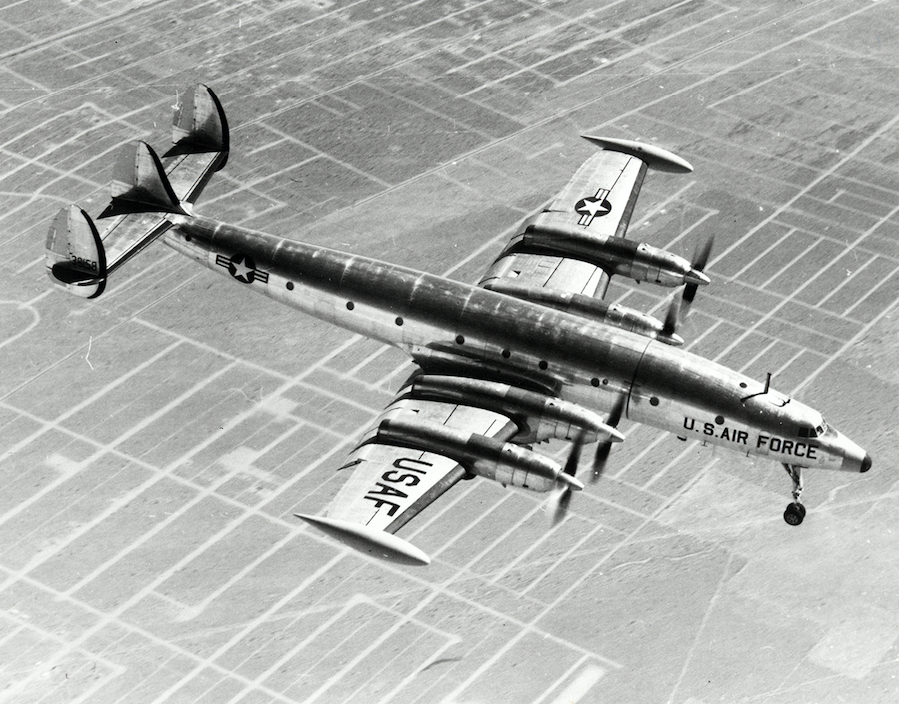
25–26 January 1957: A United States Air Force Lockheed YC-121F Super Constellation departed Long Beach Airport (LGB), Long Beach, California, at 10:22 p.m. Pacific Standard Time, 25 January (06:22, 26 January, UTC) under the command of Major Stanley Forster. Other members of the crew were Captain John P. Burkett, Master Sergeant Conrad S. Stevens, and Master Sergeant Travis B. Hodges. A civilian news representative, Joseph W. Draper, was also on board.
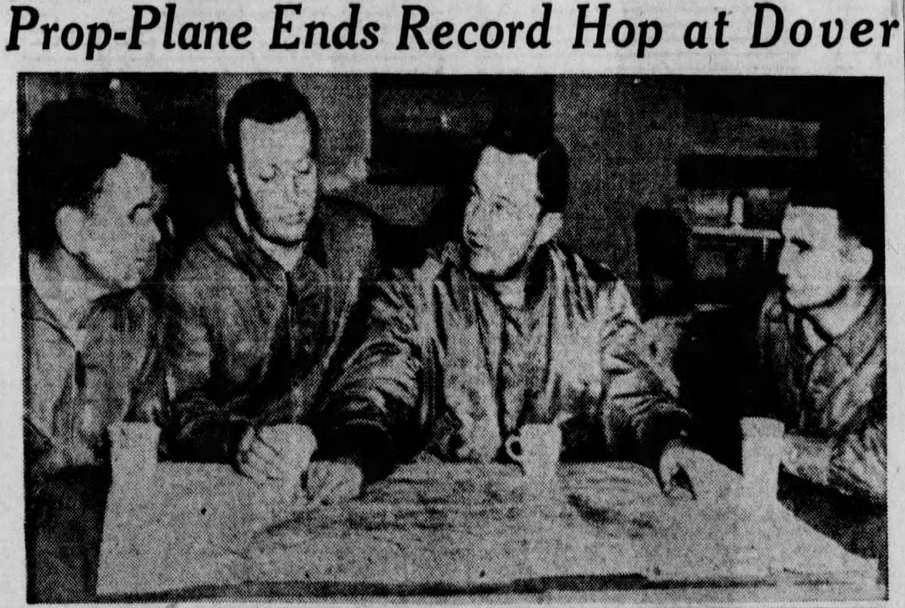
Flying at an altitude of 27,000 feet (8,230 meters) the Lockheed flew 2,033 nautical miles (2,340 statute miles/3,766 kilometers) across the continent to Andrews Air Force Base (ADW), Camp Springs, Maryland. The airplane crossed overhead at 6:05 a.m, 26 January, Eastern Standard Time (11:05 UTC), for an elapsed time of 4 hours, 43 minutes.
The YC-121F had averaged 424.66 knots (488.69 miles per hour/786.47 kilometers per hour) between Long Beach and Andrews.
Unable to land at Andrews because of adverse weather conditions, the YC-121F proceeded to Dover, Delaware, where it touched down at 6:29 a.m., EST, 26 January (11:29, 26 January, UTC). The total duration of the flight was 5 hours, 7 minutes.
The YC-121F was one of two assigned to the 1700th Test Squadron, Military Air Transport Service (MATS), at Kelly Air Force base, San Antonio, Texas, along with turboprop-driven Boeing KC-97 Stratocruisers and Douglas C-124 Globemasters. The airplanes were used to test various combinations of engines and propellers.
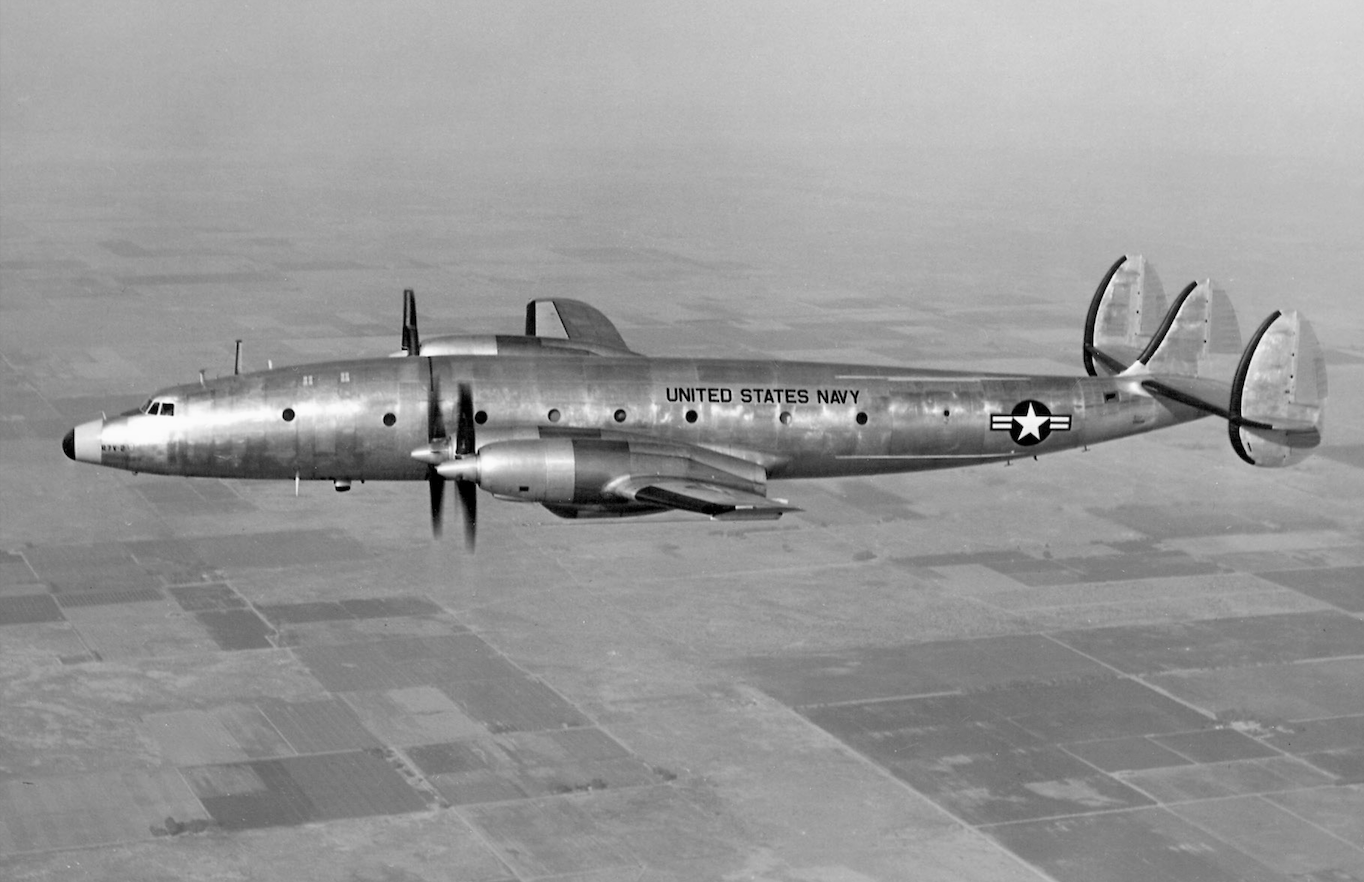
Lockheed Aircraft Corporation built four R7V-2s at its plant in Burbank, California, for the U.S. Navy. They were assigned Bureau of Aeronautics serial number (“Bu. Nos.”) 131630, -631, -660 and -661. The first two R7V-2s, -630 and -631, were transferred to the U.S. Air Force, re-designated YC-121F and assigned Air Force serial numbers 53-8157 and 53-8158. The airplanes’ Lockheed model numbers were L-1249A-94-75. The YC-121F made its first flight in April 1955.
The R7V-2/YC-121F was the ultimate variant of Lockheed’s Constellation series. It was normally operated by a flight crew of five, and could carry 106 passengers, or 24,210 pounds (10,981 kilograms) of cargo. The airplane was 115 feet, 10 inches (35.306 meters) long, with a wingspan of 117 feet, 0 inches (35.662 meters), and overall height of 25 feet, 6 inches (7.772 meters). It had a total total wing area of 1,615 square feet (150.04 square meters). The airplane could be equipped with wingtip fuel tanks, which increased the overall span to 119 feet (36.271 meters). The YC-121F’s empty weight was 72,387 pounds (32,834 kilograms), and it had a maximum takeoff weight of 148,540 pounds (67,377 kilograms).
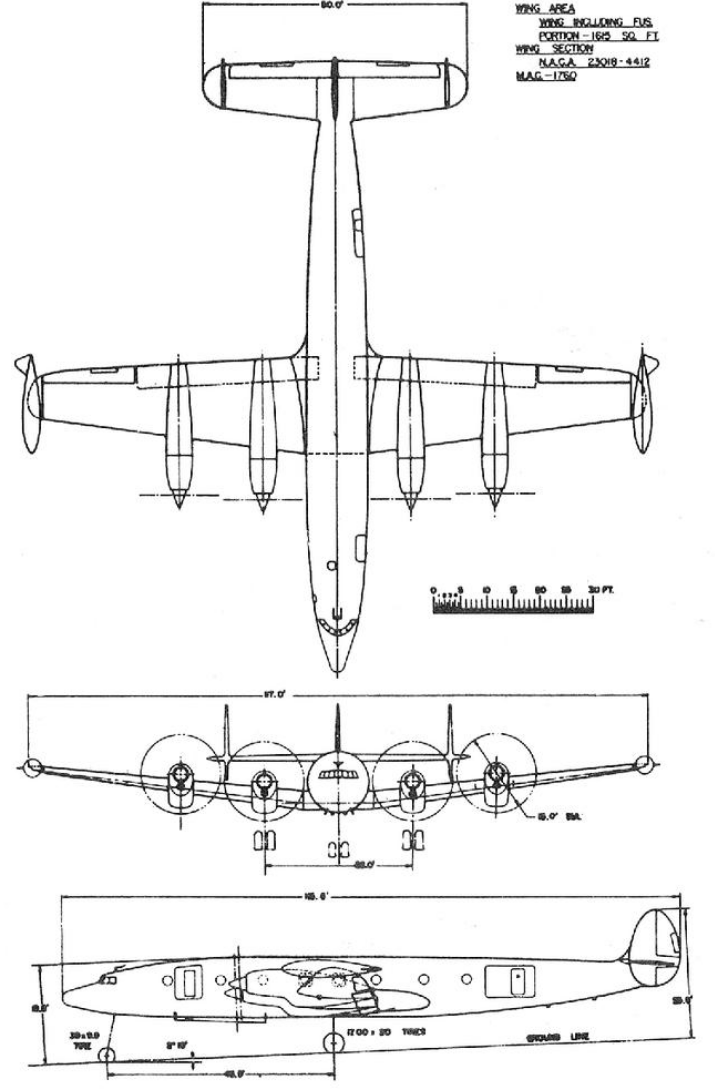
The YC-121F was powered by four Pratt & Whitney YT34-P-6 turboprop engines. The T34 was an axial-flow engine with a 13-stage compressor, 8 flame tubes, and a 3-stage turbine. The -P-6 had a normal power rating of 4,750 shaft horsepower at 10,500 r.p.m., and also produced 1,125 pounds of jet thrust. The military power rating was 5,300 s.h.p. at 11,000 r.p.m., and 1,250 pounds of thrust (30-minute limit). The takeoff power rating was 5,500 s.h.p. at 11,000 r.p.m., with 1,250 pounds of thrust (5-minute limit). The engines drove three-bladed, 16 foot, 0 inch (4.877 meters) Hamilton Standard propellers through a 0.0909:1 gear reduction.
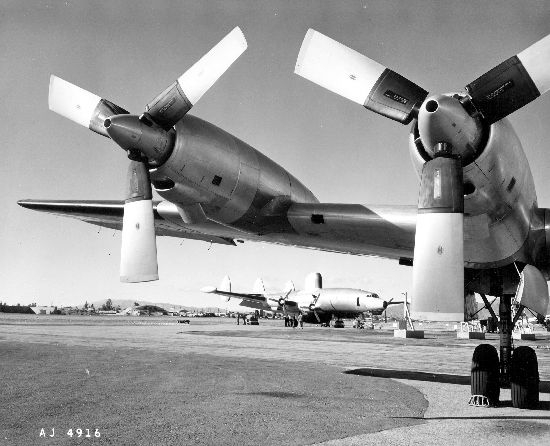
The YC-121F had a cruise speed of 310 knots (357 miles per hour/574 kilometers per hour ) at 25,000 feet (7,620 meters), and maximum speed of 386 knots (444 miles per hour/715 kilometers per hour) at 10,000 feet (3,048 meters). It had a maximum rate of climb of 4,600 feet per minute from Sea Level at combat weight. The service ceiling was 26,400 feet (8,047 meters), but it could reach 32,900 feet (10,028 meters). The transport had a maximum combat range of 1,998 nautical miles (2,299 statute miles/3,700 kilometers).
YC-121F 53-8158 was later used by Lockheed as a test bed for the Allison 501D turboprops for the L-188 Electra. It was nicknamed “Elation” (ELectra + ConstellATION). Both YC-121Fs were salvaged to rebuild two Flying Tiger Lines transports to the L-1049H configuration.
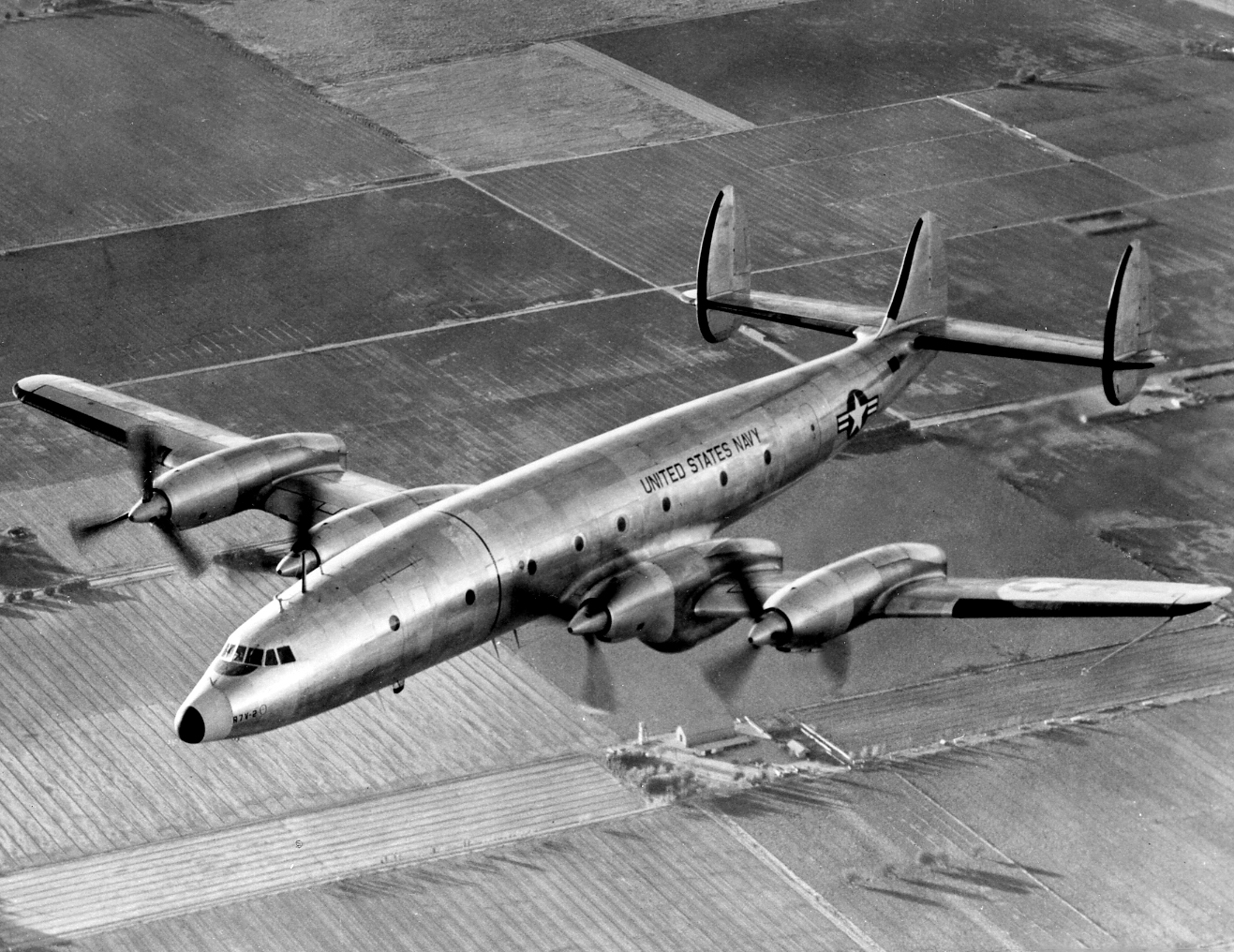
© 2020, Bryan R. Swopes
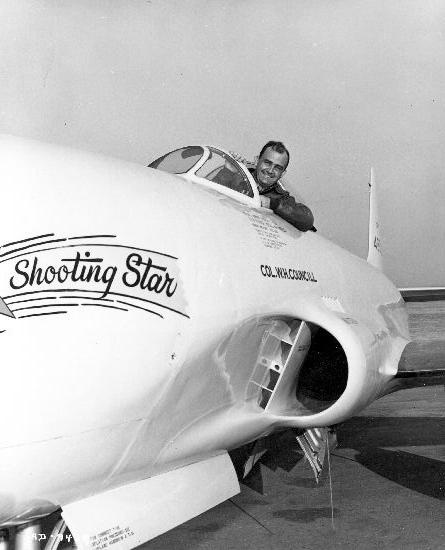
26 January 1946: Colonel William Haldane Councill, U.S. Army Air Forces, a test pilot at the Flight Test Division, Wright Field, Ohio, made a record-breaking flight from Daugherty Field (Long Beach Airport), California, to overhead LaGuardia Airport, New York, in 4 hours, 13 minutes, 26 seconds. He was piloting a Lockheed P-80A-1-LO Shooting Star, serial number 44-85123. Colonel Councill flew as high as 41,000 feet (12,497 meters), but stayed at 35,000 feet (10,668 meters) for most of the flight. This flight set a new transcontinental speed record for the 2,457 miles (3,954 kilometers), averaging 584.82 miles per hour (941.18 kilometers per hour).
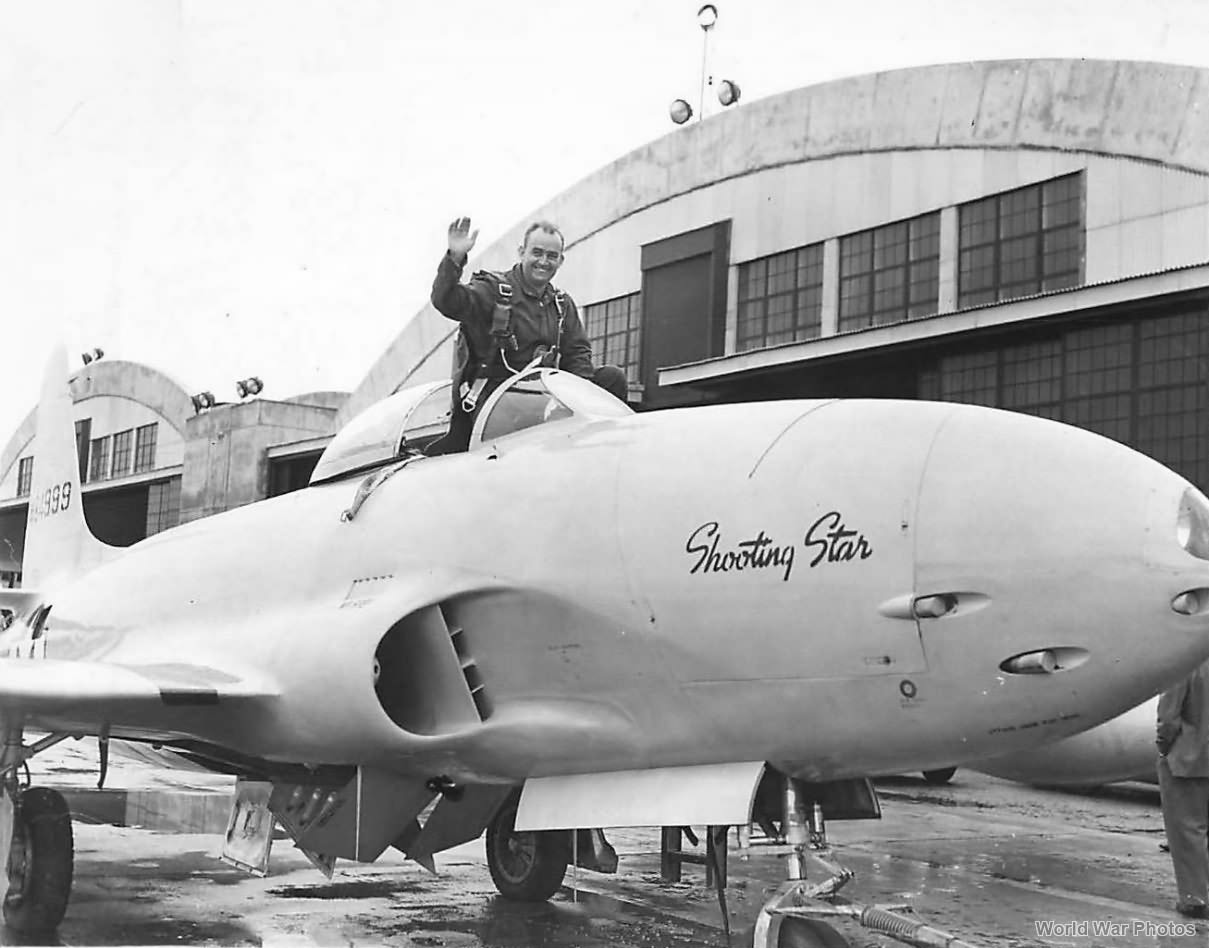
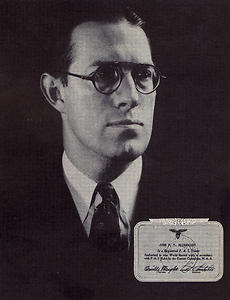
The National Aeronautic Association representative, John P. V. Heinmuller, was the official timer. (Mr. Heinmuller was the Chief Timer of both the N.A.A. and the Fédération Aéronautique Internationale. He was president of the Longines-Wittnauer Watch Co., inc. He had also timed Lindbergh’s transatlantic flight in 1927. Mr. Heinmuller was the author of Man’s Fight to Fly: Famous World-Record Flights and a Chronology of Aviation, 1944).
Colonel Councill was accompanied by two other P-80s flown by Captain John S. Babel and Captain Martin I. Smith. This was the longest non-stop flight by a jet aircraft up to that time.
Colonel Councill’s P-80A had been modified with the installation of a 100-gallon (379 liters) fuel tank in the nose in place of the standard armament of six machine guns. Along with 300-gallon (1,135 liters) wing tip tanks, the Shooting Star’s maximum fuel load had been increased to 1,165 gallons (4,410 liters).¹
The P-80s flown by Captains Babel and Smith also had the nose fuel tank installed, but carried 150-gallon (569 liters) wing tip tanks. They had to stop at Topeka, Kansas, to refuel. Ground crews met them with four fuel trucks, and they were airborne in 4 minutes and 6 minutes, respectively.
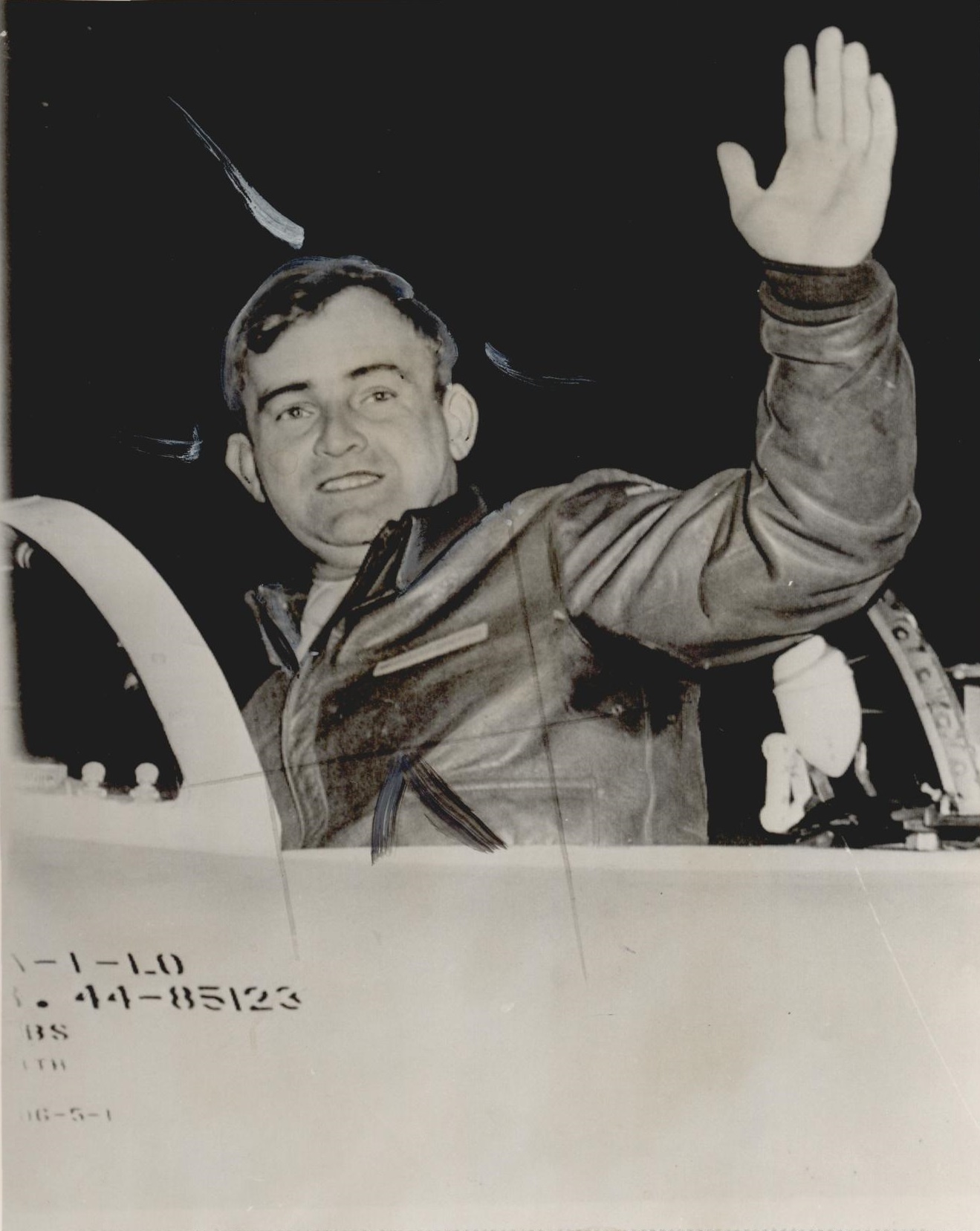
William Haldane Councill was born 5 October 1911 at Bellevue, Pennsylvania. He was the second of four children of William Mansfield Councill, a manager for a fireproofing company, and Bertha Etta Wing Councill. He attended Perry High School, where he was a member of the Aero Club.
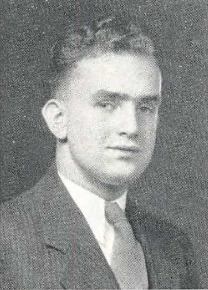
Bill Councill studied at the Carnegie Institute of Technology, Pittsburgh, Pennsylvania. He was a member of the Reserve Officers Training Corps (R.O.T.C.), and the Delta Upsilon (ΔΥ) fraternity. He was also a member of the Scabbard and Blade, and co-chairman of the Military Ball. Councill graduated in 1933 with the degree of Bachelor of Science in Mechanical Engineering (B.S.M.E.).
William H. Councill was commissioned as a second lieutenant, Engineer Reserve, 1 June 1933. He was appointed a flying cadet and trained as a pilot, 1 October 1933 to 14 October 1935. He then received a commission as a second lieutenant, Air Reserve.
Lieutenant Councill married Miss Lillie Louise Slay at Wahiawa Heights, Honolulu, Territory of Hawaii, 18 April 1936. They would have one daughter, Frances, born in 1943.
On 1 October 1938, Councill’s reserve commission was converted to second lieutenant, Air Corps, United States Army. Councill was promoted to first lieutenant, 1 October 1941.
During this time William Councill held a parallel commission in the Army of the United States. He was promoted to first lieutenant, A.U.S., 9 September 1940, and captain, A.U.S., 1 February 1942. On 1 March 1942, he was promoted to the rank of major, A.U.S. (A.C.), and to lieutenant colonel, 19 December 1942. On 3 July 1945, Councill advanced to the rank of colonel, A.U.S.
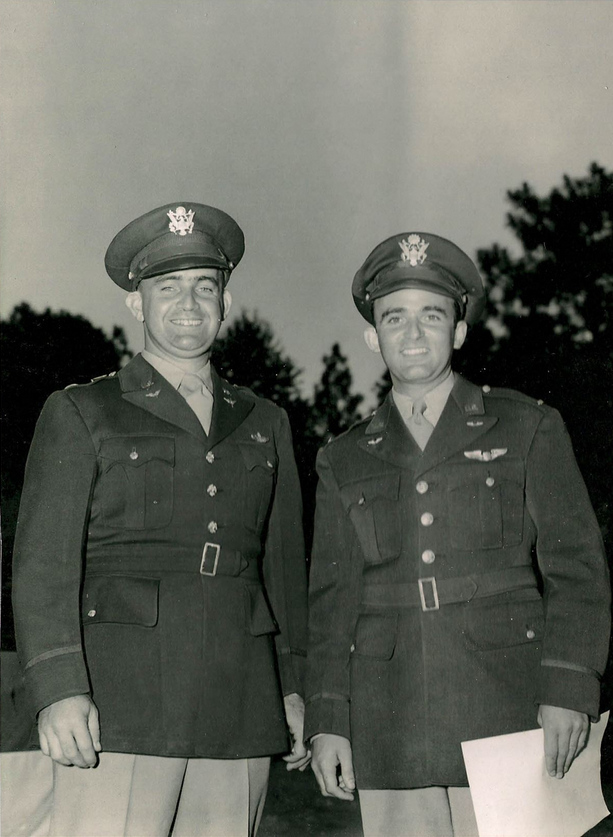
Colonel Councill was rated as a command pilot. During World War II, he flew 130 combat missions with the the Lockheed P-38 Lightning .Thirteenth Air Force in the southwest Pacific area. He is credited with shooting down three enemy aircraft, and was awarded the Distinguished Flying Cross for his actions in an air battle over the Solomons, 15 January 1943.
At 10:54 a.m., 5 April 1954, Colonel Councill took off from the Republic Aviation Company plant at Farmingdale, New York, in a Lockheed T-33A Shooting Star, en route to Langley Field, Virginia. He never arrived. An extensive search, other than locating a single wing tank, was unsuccessful. It was presumed that Councill went down in the Atlantic Ocean.
According to his commanding officer, Major General Earl W. Barnes,
“. . . He was a most capable, dependable and responsible officer who was conscientiously devoted to his tasks. His opinions on military matters were highly regarded by his superior officers. His pleasant personality, genial manner, and dry wit endeared him to the hearts of the many friends he had won during approximately twenty-one years of service in the United States Air Force. He was greatly beloved by those with whom he associated. . . I feel that our Country and the Air Force have lost an irreplaceable asset and a great leader.”
—Wing Family Annals, Wing Family of America, Inc., Des Moines, Iowa. Vol. 54, No. 1, at Pages 7 and 8
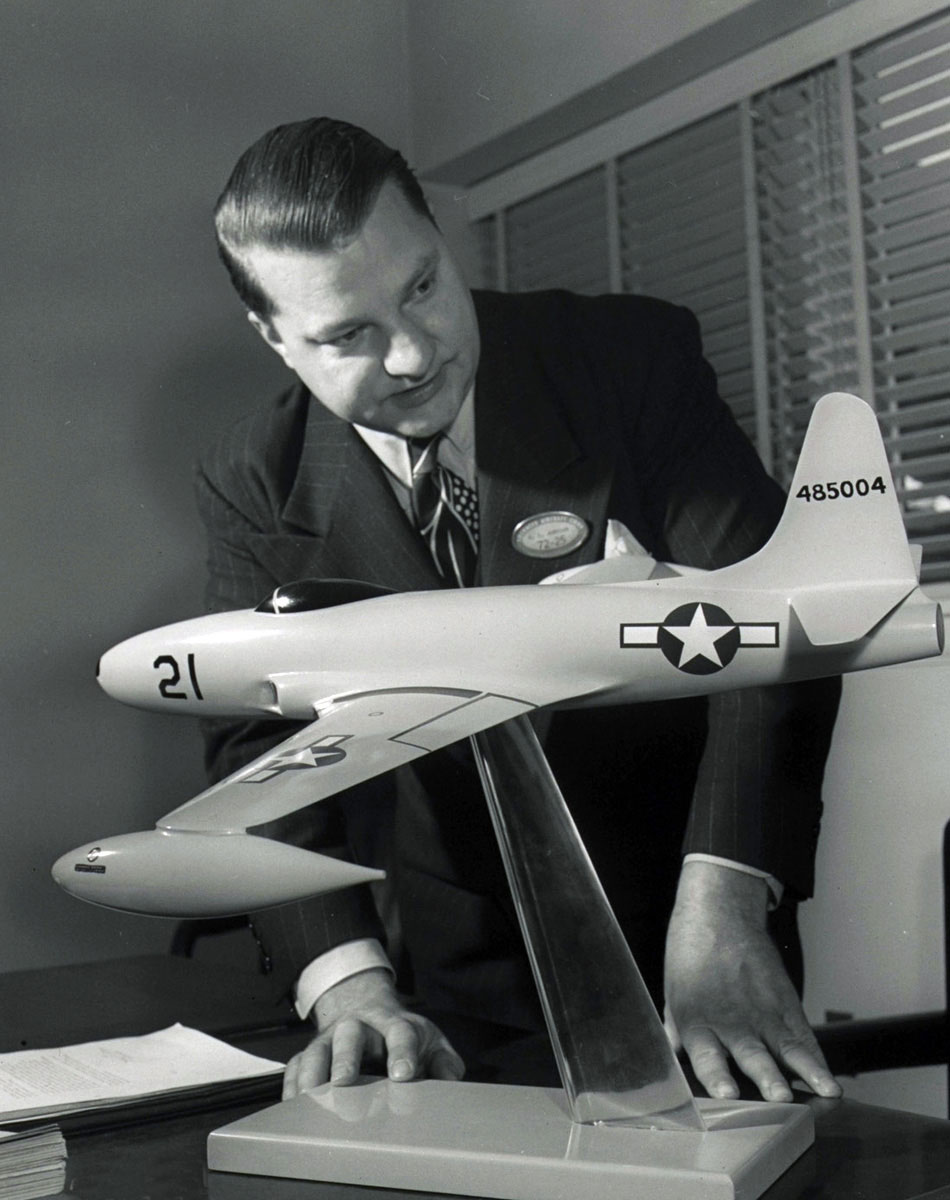
 The Lockheed P-80-1-LO was the United States’ first operational jet fighter. It was a single-seat, single engine airplane, designed by a team of engineers led by Clarence L. (“Kelly”) Johnson. The prototype XP-80A, 44-83020, nicknamed Lulu-Belle, was first flown by test pilot Tony LeVier at Muroc Army Air Field (now known as Edwards Air Force Base) 8 January 1944.
The Lockheed P-80-1-LO was the United States’ first operational jet fighter. It was a single-seat, single engine airplane, designed by a team of engineers led by Clarence L. (“Kelly”) Johnson. The prototype XP-80A, 44-83020, nicknamed Lulu-Belle, was first flown by test pilot Tony LeVier at Muroc Army Air Field (now known as Edwards Air Force Base) 8 January 1944.
The P-80A was a day fighter, and was not equipped for night or all-weather combat operations. The P-80A was 34 feet, 6 inches (10.516 meters) long with a wingspan of 38 feet, 10.5037 inches (11.84919 meters) ² and overall height of 11 feet, 4 inches (3.454 meters).
The leading edges of the P-80A’s wings were swept aft 9° 18′ 33″. They had an angle of incidence of +1° at the root and -1° 30′ twist. There was 3° 50′ dihedral. The total wing area was 237.70 square feet (22.083 square meters).
The fighter had an empty weight of 7,920 pounds (3,592 kilograms) and a gross weight of 11,700 pounds (5,307 kilograms). The maximum takeoff weight was 14,000 pounds (6,350 kilograms).
 Early production P-80As were powered by either an Allison J33-A-9 or a General Electric J33-GE-11 turbojet engine. The J33 was a licensed version of the Rolls-Royce Derwent. It was a single-shaft turbojet with a 1-stage centrifugal compressor section and a 1-stage axial-flow turbine. The -9 and -11 engines were rated at 3,825 pounds of thrust (17.014 kilonewtons). The J33s were 8 feet, 6.9 inches (2.614 meters) long, 4 feet, 2.5 inches (1.283 meters) in diameter and weighed 1,775 pounds (805 kilograms).
Early production P-80As were powered by either an Allison J33-A-9 or a General Electric J33-GE-11 turbojet engine. The J33 was a licensed version of the Rolls-Royce Derwent. It was a single-shaft turbojet with a 1-stage centrifugal compressor section and a 1-stage axial-flow turbine. The -9 and -11 engines were rated at 3,825 pounds of thrust (17.014 kilonewtons). The J33s were 8 feet, 6.9 inches (2.614 meters) long, 4 feet, 2.5 inches (1.283 meters) in diameter and weighed 1,775 pounds (805 kilograms).
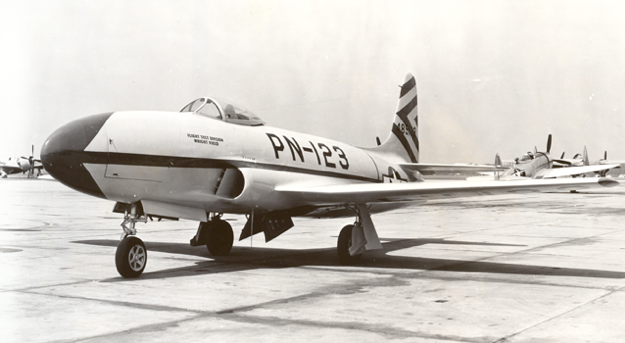
The P-80A had a cruising speed of 445 miles per hour (716 kilometers per hour) at 20,000 feet (6,096 meters). Its maximum speed was 548 miles per hour (882 kilometers per hour) at 2,700 feet (823 meters) and and 501 miles per hour (806 kilometers per hour) at 34,700 feet (10,577 meters). The service ceiling was 45,000 feet (13,716 meters).
The P-80A Shooting Star was armed with six air-cooled Browning AN-M2 .50-caliber aircraft machine guns mounted in the nose.
Several hundred of the early production P-80 Shooting stars had all of their surface seams filled, and the airplanes were primed and painted. Although this process added 60 pounds (27.2 kilograms) to the empty weight, the decrease in drag allowed a 10 mile per hour (16 kilometers per hour) increase in top speed. The painted surface was difficult to maintain in the field and the process was discontinued.
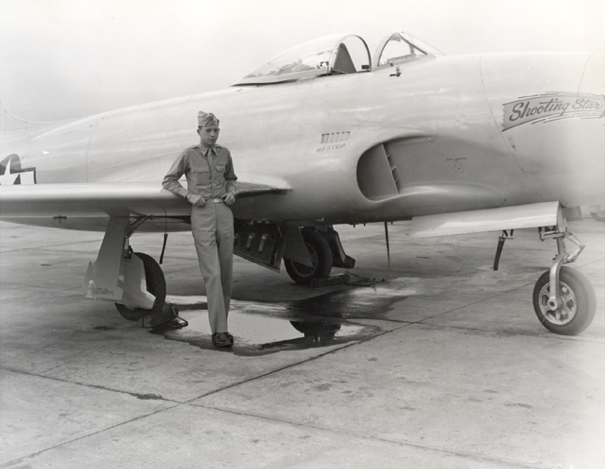
On 3 June 1946, Lockheed P-80A-1-LO Shooting Star 44-85123, flown by Lieutenant Henry A. Johnson, set a Fédération Aéronautique Internationale (FAI) World Record for Speed Over a Closed Circuit of 1,000 Kilometers with an average speed of 745.08 kilometers per hour (462.97 miles per hour).³
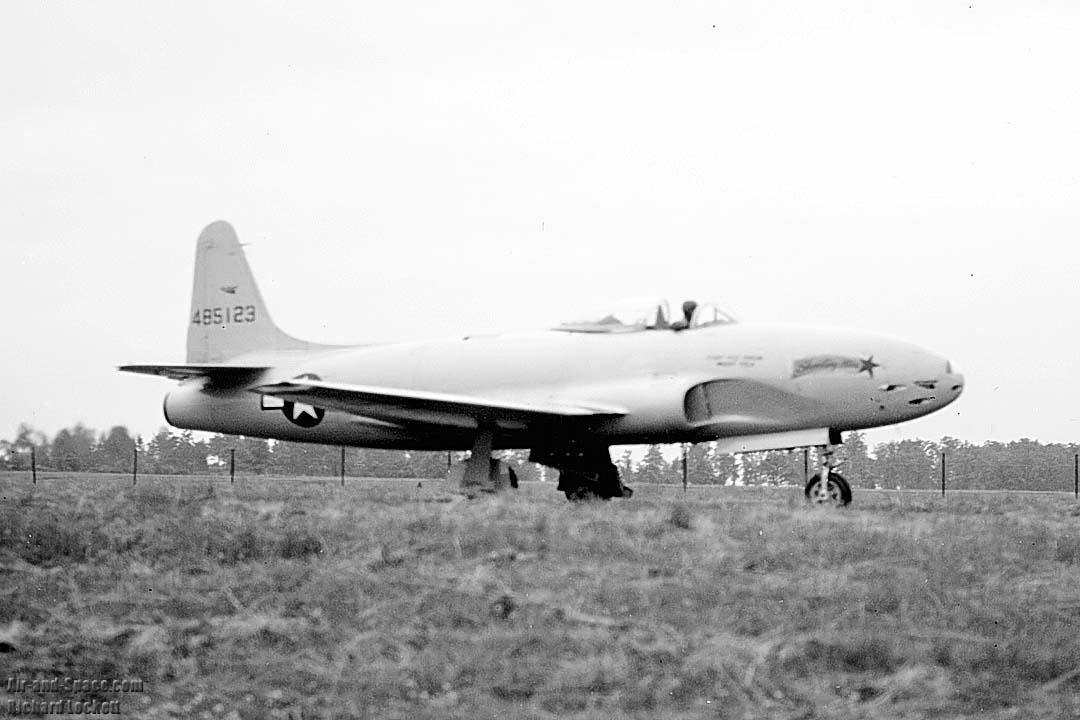
On 2 September 1946, Major Gustav Lindquist won the Thompson Trophy Race, J Division, at the National Air Races, Cleveland, Ohio, 1946, with the same airplane, averaging 515.853 miles per hour (830.185 kilometers per hour) over a 180-kilometer (111.85-mile) course.
Today, 44-85123 is in the collection of the Air Force Flight Test Museum, Edwards Air Force Base.
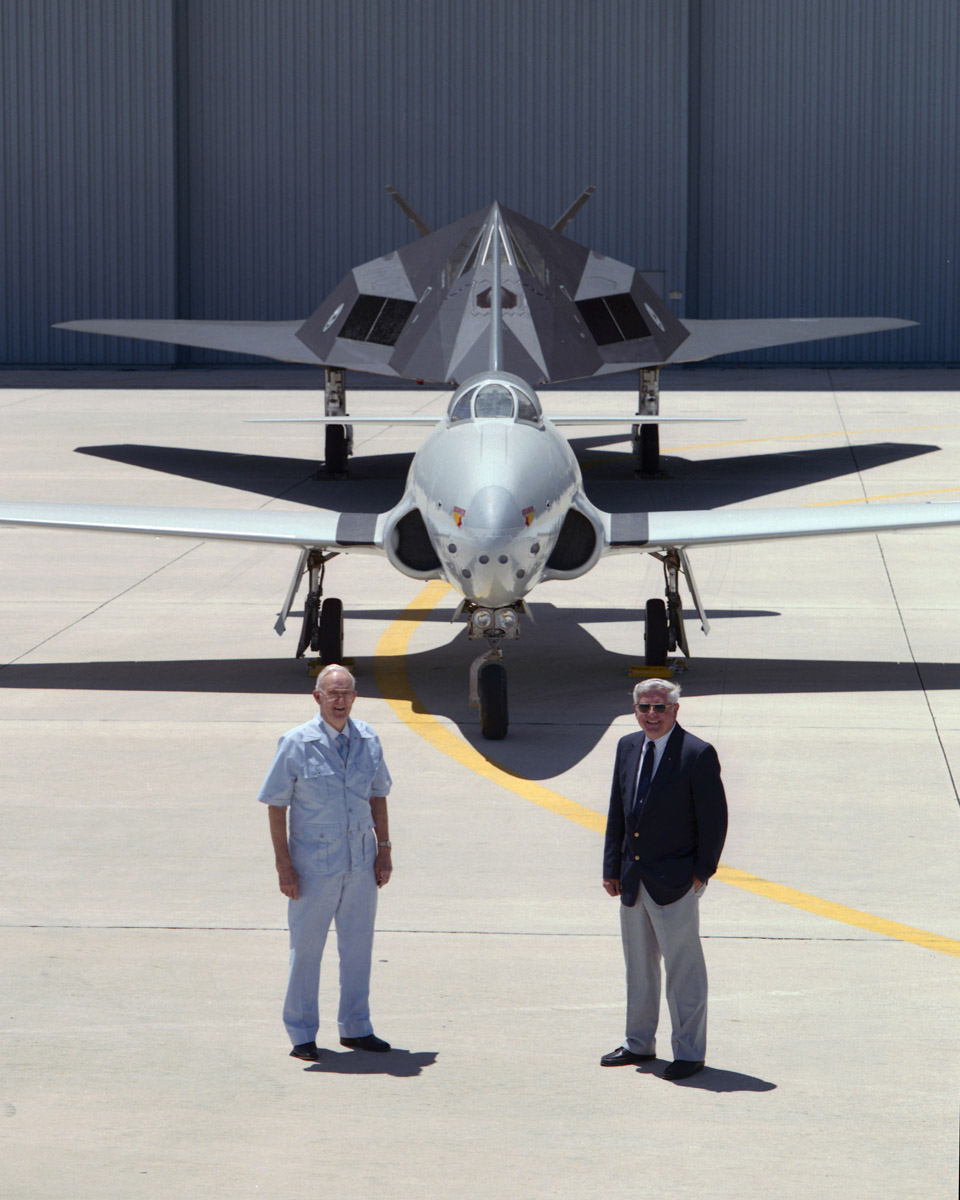
¹ Thanks to Jeffrey P. Rhodes of Lockheed Martin for additional information on Colonel Councill’s Lockheed P-80A Shooting Star.
² Wing span with rounded wing tips. P-80As with squared (“clipped”) tips had a wing span of 37 feet, 7.5037 inches (11.46819 meters).
³ FAI Record File Number 10973
© 2019, Bryan R. Swopes